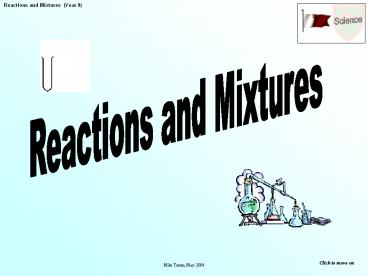Reactions and Mixtures - PowerPoint PPT Presentation
1 / 7
Title:
Reactions and Mixtures
Description:
Click to move on Pure Substances Pure substances contain only one sort of particle. Many substances that in everyday language we call pure are really mixtures. – PowerPoint PPT presentation
Number of Views:76
Avg rating:3.0/5.0
Title: Reactions and Mixtures
1
Reactions and Mixtures
Click to move on
2
Pure Substances
- Pure substances contain only one sort of
particle. Many substances that in everyday
language we call pure are really mixtures. - For example, a bottle of pure mineral water has,
according to the label, the following contents - Calcium
- Magnesium
- Sodium
- Potassium
- Bicarbonate
- Chloride
- Sulphate
- Fluoride!
- If it was really pure water, in the scientific
meaning of the word, it would contain only water
particles, H20.
When we cook, we nearly always make use of
mixtures. Mixtures often make very useful
materials. They have different properties from
the pure substances that make them.
The next two slides go over work from the
Building Blocks topic. It is important that you
know the work from that topic well if you are to
understand this one.
Click to move on
3
Elements, Molecules and Compounds
Some elements, such as the noble gases, exist as
individual atoms.
Often, elements consist of two or more atoms
joined together. We call these molecules.
If more than one type of atom is in a molecule,
we call it a compound.
Click to move on
4
Element or Compound?
methane, CH4
sulphur, S8
compound
element
(Click for answer)
(Click for answer)
hydrogen peroxide, H2O2
sulphuric acid, H2SO4
compound
compound
(Click for answer)
(Click for answer)
oxygen (ozone), O3
carbon (buckyball), C60
element
element
(Click for answer)
(Click for answer)
Click to move on
5
Mixtures
This is a mixture of elements made up of atoms,
elements made up of molecules, and compounds. In
a mixture, the particles are not joined together.
Atom, molecule or compound? (click for answer)
atom
Atom, molecule or compound? (click for answer)
molecule
Atom, molecule or compound? (click for answer)
compound
Click to move on
6
Chemical Reactions
Chemical reactions, or chemical changes, happen
when the atoms in one or more chemicals split up
and join together in new ways. For example,
hydrogen can react with oxygen
hydrogen oxygen
water
Before the reaction the oxygen atoms go round in
pairs, and the hydrogen atoms go round in pairs.
When they react we get two new molecules, of the
compound water. Each of these molecules has
three atoms, two hydrogen atoms joined to one
oxygen atom. We can write this as H2O.
Click to move on
7
Types of Reaction
There are several different groups that we can
put reactions into. These include
combustion displacement enzyme neutralisation o
xidation precipitation thermal decomposition
The reaction of sugar with concentrated sulphuric
acid.
When a reaction takes place, things happen. There
may be a gas given off, a colour change or a
solid material appearing. There could also be
changes we cant see, such as a temperature
change. One important thing to remember about
chemical reactions is that the mass of the
reactants (the chemicals we start with) is always
the same as the mass of the products (the
chemicals we end with).
Click to move on































